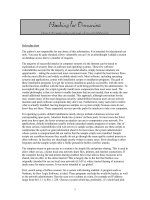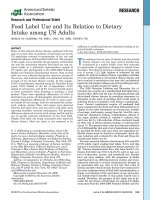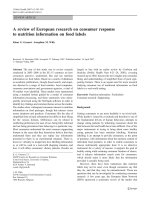Food label requirements made simple
Bạn đang xem bản rút gọn của tài liệu. Xem và tải ngay bản đầy đủ của tài liệu tại đây (261.86 KB, 19 trang )
Food Label Requirement Made Simple
A guide for the FDA food label regulations
Written by
Orit Pennington
TPGTEX Label Solutions
October 2009
This guide is written under the Attribution-Noncommercial-Share Alike license. (
see Appendix I)
Food Label Requirement Made Simple TPGTEX Label Solutions
Orit Pennington Page 2 10/26/2009
Table of Content
Introduction 3
What is a food label anyway? 4
Small Business Exemption 5
Heading 5
How large must the Nutrition Facts Heading be? 5
Font and Spacing Requirements 6
What is the "right" Serving Size? 7
Common Household Measures 7
What is "Calorie Free" Food? 8
The Parts of the Central Section 9
What and How Claims and Statement are Written? 10
What is a Disclosure Statement? 12
The Ingredient List 13
Water as an ingredient 14
FALCPA Regulation 15
What is PDP? 17
What Should be Displayed on the PDP? 17
Print Size - use prominent, conspicuous and easy to read print size 18
Appendix I 19
Attribution-Noncommercial-Share Alike 19
You are free: 19
Under the following conditions: 19
With the understanding that: 19
Food Label Requirement Made Simple TPGTEX Label Solutions
Orit Pennington Page 3 10/26/2009
Introduction
TPGTEX Label Solutions is a company whose main specialty is finding solutions to any label printing issue. Over
the years TPGTEX has developed many software applications to help in the creation of labels. The Food
Labeling System was developed to automate the creation of food labels. The program includes a product
manager that stores all needed information for the purpose of printing food labels with nutrition panel.
This document was prepared in an effort to help our customers who are small food manufacturers and
processors. Like so many, they have a great food product that they worked very hard on developing. They wanted
to start marketing it to local grocery store chains, gifts shops, etc. What they did not have was good information –
or guideline as to what needed to be on the food label.
The FDA and USDA sites are full of information about the food label. However, most of the information is written
in a way that will be hard for most people to understand. It is very long and very detailed.
This guide touches on all sections of the food label (front and nutrition Panel). Each section is explained and the
most common expressions are explained as well. When ever possible, examples were added.
We hope this guide helps make things a little simpler for you.
Good Lack with your product.
TPGTEX Label Solutions, Inc.
Write to us: 5830 Ludington Dr, Houston, Texas 77035
Email us:
Call us: 713.726.9636
Visit us on the web:
The information provided here is based on the FDA website where you can get more specific information. This guide is intended to help you
sort through the main parts of the labeling requirements. It is not meant to replace the FDA guide.
Food Label Requirement Made Simple TPGTEX Label Solutions
What is a food label anyway?
The purpose of the food label is to inform the consumer in a clear way what is the content of the
food package.
A food label is comprised of two main parts: the front and the nutrition information.
The two parts can be together on one label or can be divided to two labels.
1. The front part contains the name of the product and the weight.
2. The nutrition panel contains all nutritional information as well as ingredient list and any statements and
disclaimers.
Orit Pennington Page 4 10/26/2009
Food Label Requirement Made Simple TPGTEX Label Solutions
Orit Pennington Page 5 10/26/2009
Small Business Exemption
Small business may be exempt from some of these requirements and can apply for the exemption to the FDA.
The FDA defines small business in these terms:
" low-volume products, applies if the person claiming the exemption employs fewer than an
average of 100 full-time equivalent employees and fewer than 100,000 units of that product are
sold in the United States in a 12-month period." Exemptions can now be filed
online.
Heading
How large must the Nutrition Facts Heading be?
The "Nutrition Facts" heading must be in a type size larger than all other print size in the nutrition label (21 CFR
101.9(d)(2)). Minimum type sizes of 6 point and 8 point are required for the other information in the nutrition label
(21 CFR 101.9(d)(1)(iii)), and there are minimum spacing requirements between lines of text (21 CFR
101.9(d)(1)(ii)(C)).
Small food packages may have different requirements.
The FDA defines small packages as:
" Food packages with a surface area of 40 sq. in. or less "
Food Label Requirement Made Simple TPGTEX Label Solutions
Font and Spacing Requirements
*Source
www.fda.gov
Orit Pennington Page 6 10/26/2009
Food Label Requirement Made Simple TPGTEX Label Solutions
Orit Pennington Page 7 10/26/2009
What is the "right" Serving Size?
To determine the right serving size portions use these three simple steps:
1. First Step: Determine your food category using the Reference Amount Customarily Consumed (RACC)
tables. Click here to go to
[table 1], [table 2] - both tables can also be found on the www.gpoaccess.gov
site.
2. Second Step: Determine appropriate serving size. If your product is sold in small units it is required to be
labeled as single serving container. Labeling requirements for single-serving containers can be found
here
21 CFR 101.9(b)(6).
3. Third Step: Determine the number of serving for your food package.
Serving size is expressed as a common household measure followed by the equivalent metric quantity in
parenthesis (e.g., "1/4 cup (112 g)").
Common Household Measures
21 CFR 101.9(b)(5)
(5)For labeling purposes, the term common household measure or common household unit means cup,
tablespoon, teaspoon, piece, slice, fraction (e.g., 1/4 pizza), ounce (oz), fluid ounce (fl oz), or other common
household equipment used to package food products (e.g., jar, tray). In expressing serving size in household
Food Label Requirement Made Simple TPGTEX Label Solutions
Orit Pennington Page 8 10/26/2009
measures, except as specified in paragraphs (b)(5)(iv), (b)(5)(v), (b)(5)(vi), and (b)(5)(vii) of this section, the
following rules shall be used:
(i) Cups, tablespoons, or teaspoons shall be used wherever possible and appropriate except for beverages. For
beverages, a manufacturer may use fluid ounces. Cups shall be expressed in 1/4- or 1/3-cup increments.
Tablespoons shall be expressed as 1, 1 1/3, 1 1/2, 1 2/3, 2, or 3 tablespoons. Teaspoons shall be expressed as
1/8, 1/4, 1/2, 3/4, 1, or 2 teaspoons.
(ii) If cups, tablespoons or teaspoons are not applicable, units such as piece, slice, tray, jar, and fraction shall be
used.
What is "Calorie Free" Food?
" Foods with less than 5 calories meet the definition of "calorie free" and any differences are
dietarily insignificant "
Calories should always be rounded. They are either rounded to the nearest 5 or 10
How are Calories Rounded?
Calories must be rounded as follows:
50 calories or less: Round to nearest 5-calorie increment.
Example: Round 47 calories to "45 calories"
Above 50 calories: Round to nearest 10-calorie increment.
Example: Round 96 calories to "100 calories"
Additional information about this subject can be found here
21 CFR 101.9(c)(1)
Food Label Requirement Made Simple TPGTEX Label Solutions
Orit Pennington Page 9 10/26/2009
The Parts of the Central Section
• Trans Fat Labeling - FDA is requiring that trans fatty acids be listed in nutrition labeling to assist
consumers in maintaining healthy dietary practices.
• Trans fatty acids should be listed as "Trans fat" or "Trans" on a separate line under the listing of
saturated fat in the Nutrition Facts label. Trans fat content must be expressed as grams per serving to the
nearest 0.5-gram.
• Vitamins and Minerals - Generally, FDA only requires that the label declare the vitamins A and C, and
the minerals calcium and iron.
• Declare other vitamins and minerals when they are added directly to the packaged food (e.g., enriched
bread), but not when the enriched product is added as an ingredient to another food.
• Daily Value - This value must be calculated and presented for any nutrient that is mandatory on the label.
In addition, any other nutrient that has been added and has an established DV%, need to have that value
as well.
• Nutrients not included in the required list - manufacturers may add calories from saturated fat,
polyunsaturated fat, monounsaturated fat, potassium, soluble and insoluble fiber, sugar alcohol, other
carbohydrate, vitamins and minerals for which Reference Daily Intake (RDI's) have been established, or
the percent of vitamin A that is present as beta-carotene.
21 CFR 101.9(c)
Be sure to consult the guide provided on the
FDA site for specific information, requirements, and
regulations concerning your product.
Food Label Requirement Made Simple TPGTEX Label Solutions
What and How Claims and Statement are Written?
The Claims and Statement section was created for the use of additional nutrient content claims on labels in
accordance with provisions of the Nutrition Labeling and Education Act of 1990.
Antioxidant: An antioxidant nutrient content claim can only be made for nutrients for which there is an established
RDI.
Note: The antioxidant nutrient must meet the requirements for nutrient content claims for High claims, Good
source claims, and More claims, respectively (in 21 CFR 101.54(b),(c),or(e)).
Example: To use a high claim, the food would have to contain 20% or more of the Daily Reference Value (DRV)
or RDI per serving. For a good source claim, the food would have to contain between 10-19% of the DRV or RDI
per serving.
Example of correct usage: "high in antioxidant vitamins C and E"
Fiber: You can use "high", "good source" or "more". However; if the food is NOT "low" in total fat, then the label
must include the level of total fat per labeled serving.
Sugar Free: food that contains less than 0.5 g of sugars. Terms such as "free of sugar", "no sugar", "zero sugar",
"without sugar", "sugarless", "trivial source of sugar", "negligible source of sugar", "dietarily insignificant source of
sugar" can also be used. However; If the food is NOT also low or reduced in calorie that fact must be disclose.
Fat Free: food contains less than 0.5 grams fat per serving. RAW serving. 3
Descriptive Terms: Each term can only be used if the nutrient it refers to is contained in the food product at a
minimum percentage or above.
"high potency": food contains 100 percent or more of vitamins or minerals (RDI).
Orit Pennington Page 10 10/26/2009
Food Label Requirement Made Simple TPGTEX Label Solutions
Example of correct usage: "Botanical X with high potency vitamin E."
"more", "fortified", "enriched", "added", "extra", and "plus" : food contains at least 10 percent more of the RDI.
Used in the description of protein, vitamins, minerals, dietary fiber, or potassium.
"rich in", or "excellent source of": food contains 20 percent or more of the RDI or the DRV.
"good source", "contains", or "provides": food contains 10 to 19 percent of the RDI or the DRV.
"light" can be used only if the consumer would generally recognize it as a food that is improved in its nutrient
value compared to other average products of its type.
"reduced", "less", "fewer", and "light" : the label must state each of the following (these are called
"accompanying information"):
1. The percentage or fraction by which the food has been modified,
2. The reference food, and
3. The amount of nutrient (that is the subject of the claim) that is in the labeled food and in the reference food.
Orit Pennington Page 11 10/26/2009
Food Label Requirement Made Simple TPGTEX Label Solutions
Orit Pennington Page 12 10/26/2009
What is a Disclosure Statement?
Disclosure statement " is a statement that calls the consumer's attention to one or more nutrients in the food
that may increase the risk of a disease or health-related condition that is diet related. The disclosure statement is
required when a nutrient in a food exceeds certain prescribed levels."
" disclosure statement is required when a NCC is made and the food contains one or more of the following
nutrients in excess of the levels listed below per Reference Amount Customarily Consumed (RACC), per labeled
serving, or, for foods with small serving sizes, per 50 grams."
Total Fat 13.0 grams
Saturated Fat 4.0 grams
Cholesterol 60 milligrams
Sodium 480 milligrams
Be sure to consult the guide provided on the FDA site for specific information, requirements, and regulations
concerning your product.
Food Label Requirement Made Simple TPGTEX Label Solutions
Orit Pennington Page 13 10/26/2009
The Ingredient List
• List ingredients in descending order, sorted by weight. The ingredient with most weight is listed first, and
the ingredient with the least weight is listed last.
• list the common or usual name for ingredients unless there is a regulation that provides for a different
term. For instance, use the term "sugar" instead of the scientific name "sucrose."
Example - INGREDIENTS: Apples, Sugar, Water, and Spices
• Trace ingredients do not need to be listed if a substance is an incidental additive and has no function or
technical effect in the finished product. Sulfites are considered to be incidental only if present at less than
10 ppm.
• Chemical preservatives that are added to a food, must be included using both the common or usual name
of the preservative and the function of the preservative by including terms, such as "preservative" "to
retard spoilage" "a mold inhibitor" "to help protect flavor" or "to promote color retention."
Example - INGREDIENTS: Dried Bananas, Sugar, Salt, and Ascorbic Acid to
Promote Color Retention.
• Spices may be declared in ingredient lists by using either specific common or usual names or by using
the declarations "spices," "flavor" or "natural flavor," or "artificial flavor."
Example - INGREDIENTS: Apple Slices, Water, Cane Syrup, Corn Syrup,
Modified Corn Starch, Spices, Salt, Natural Flavor and Artificial Flavor
Food Label Requirement Made Simple TPGTEX Label Solutions
Orit Pennington Page 14 10/26/2009
Water as an ingredient
" Water added in making a food is considered to be an ingredient. The added water must be identified in the list
of ingredients and listed in its descending order of predominance by weight. If all water added during processing
is subsequently removed by baking or some other means during processing, water need not be declared as an
ingredient."
Compliance Policy Guide 555.875
Example - Can of beans:
INGREDIENTS: Pinto Beans, Water, Salt.
Example - Cookies:
INGREDIENTS: Flour, Sugar, butter, vanilla extract.
In the "beans" example, water is a part of the ingredient list. However, it is NOT part of the "cookies" example
because all water has been removed during the baking process.
Be sure to consult the guide provided on the
FDA site for specific information, requirements, and
regulations concerning your product.
Food Label Requirement Made Simple TPGTEX Label Solutions
FALCPA Regulation
FALCPA - Is the Food Allergen Labeling and Consumer Protection Act of 2004.
FALCPA addresses the labeling of all packaged foods regulated by the FDA. In Addition labeling having to do
with meat products, poultry products, and egg products are regulated by the U.S. Department of Agriculture
(USDA.)
Major food allergen is an ingredient that is one of the following eight foods or food groups or an ingredient that
contains protein derived from one of them:
milk crustacean shellfish
fish egg
tree nuts wheat
peanuts soybeans
Although more than 160 foods have been identified to cause food allergies in sensitive individuals, the "major food
allergens" account for 90 percent of all food allergies.
Allergens other than the major food allergens are not subject to FALCPA labeling requirements.
• Tree nuts, Crustacean shellfish and fish must be declared specifically.
For Tree Nuts: almonds, pecans, walnuts, etc.
For fish: bass, flounder, cod, etc.
For Crustacean shellfish: crab, lobster, shrimp, etc.
• Wheat refers to any species in the genus Triticum: wheat, durum wheat, club wheat, spelt, semolina,
Einkorn , emmer, kamut and triticale.
Orit Pennington Page 15 10/26/2009
Food Label Requirement Made Simple TPGTEX Label Solutions
FALCPA requires food manufacturers to label food products that are made with an ingredient that is a major food
allergen in one of the following two ways:
Orit Pennington Page 16 10/26/2009
Food Label Requirement Made Simple TPGTEX Label Solutions
Orit Pennington Page 17 10/26/2009
What is PDP?
PDP - Principal Display Panel
The FDA defines the PDP in these terms:
" The PDP, is that portion of the package label that is most likely to be seen by
the consumer at the time of purchase. Many containers are designed with two or
more different surfaces that are suitable for display as the PDP. These are
alternate PDPs."
21 CFR 101.1
What Should be Displayed on the PDP?
There are two statements that must appear on the PDP:
Statement of Identity = The name of the food.
1. Use common or usual name. If none exists, use a descriptive term. The label may, in addition, bear a
fanciful name which is not false or misleading.
2. Name should include description such as: whole, slices, diced, etc., unless it can be seen through the
package.
Net Quantity of Contents Statement = The weight of the product (in ounces and grams, for beverages in
liquid ounces)
Identification of Manufacturer/distributor/packer - This information can either be placed on the PDP or if more than
one label is used on a product, it can also be placed on the second label.
Food Label Requirement Made Simple TPGTEX Label Solutions
The information must include the following:
1. Name and address of the manufacturer, packer or distributor. Unless the name given is the actual
manufacturer, it must be accompanied by a qualifying phrase which states the firm's relation to the product (e.g.,
"manufactured for "or "distributed by").
2. Street address if the firm name and address are not listed in a current city directory or telephone book;
3. City or town;
4. State (or country, if outside the United States); and
5. ZIP code (or mailing code used in countries other than the United States).
The Layout of the PDP
Print Size - use prominent, conspicuous and easy to read print size.
Use letters that are at least one-sixteenth (1/16) inch in height based on the lower case letter "o". The letters must
not be more than three times as high as they are wide, and the lettering must contrast sufficiently with the
background so as to be easy to read. Do not crowd required labeling with artwork or non-required labeling.
Print Type - statement of identity shall be presented in bold type.
Orit Pennington Page 18 10/26/2009
Food Label Requirement Made Simple TPGTEX Label Solutions
Orit Pennington Page 19 10/26/2009
Appendix I
Attribution-Noncommercial-Share Alike
You are free:
• to Share — to copy, distribute and transmit the work
• to Remix — to adapt the work
Under the following conditions:
Attribution — You must attribute the work in the manner specified by the author or licensor (but not in
any way that suggests that they endorse you or your use of the work)
• Noncommercial — You may not use this work for commercial purposes.
• Share Alike — If you alter, transform, or build upon this work, you may distribute the resulting
work only under the same or similar license to this one.
With the understanding that:
• Waiver — Any of the above conditions can be waived if you get permission from the copyright
holder.
• Other Rights — In no way are any of the following rights affected by the license:
o Your fair dealing or fair use rights;
o The author's moral rights;
o Rights other persons may have either in the work itself or in how the work is used, such
as publicity or privacy rights.
• Notice — For any reuse or distribution, you must make clear to others the license terms of this
work.









